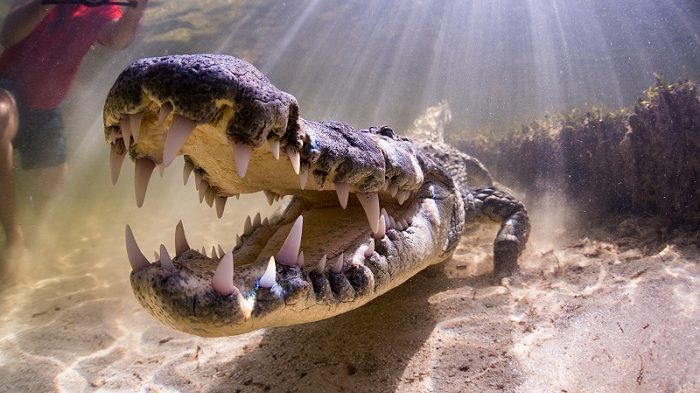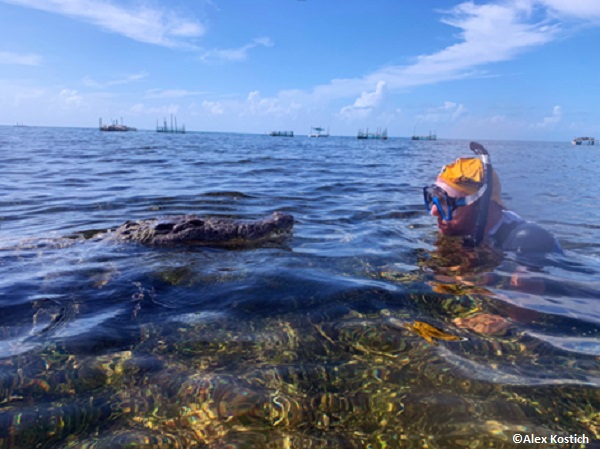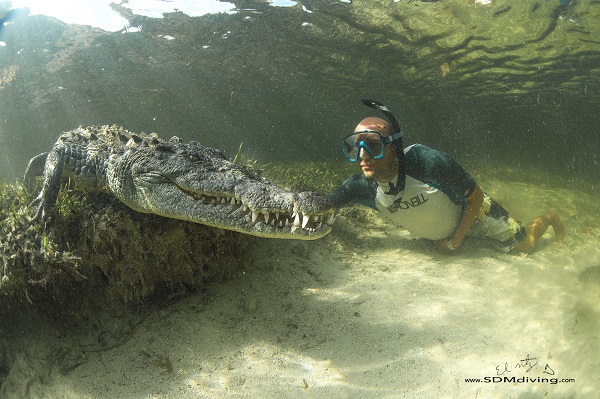“You cannot dive with crocodiles, they’ll kill you!
Well, I’ve already dived with white sharks and then returned home alive with all my body parts.
But crocodiles are much more dangerous than sharks!
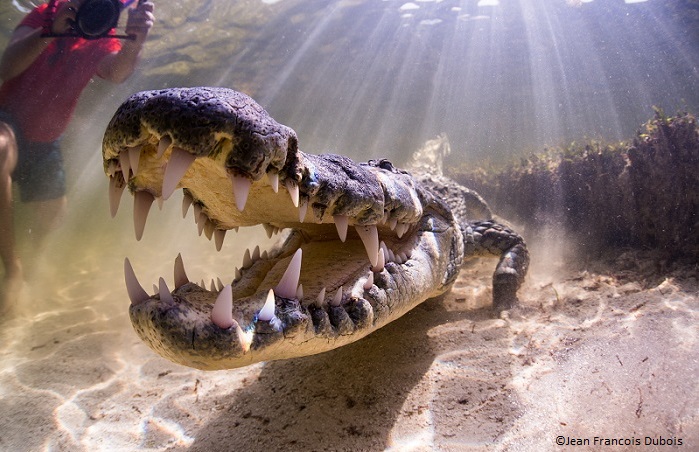
Many conversations like this took place between my friends and me after I told them I would scuba dive in Mexico with wild crocodiles.
Insane? A little bit. I like to call it a calculable risk.
I’m a TV journalist and author, I wrote three books about sharks and one about crocodiles. More specifically, about crocodile attacks. Some people even call me an expert. But my knowledge, at least as far as the crocodiles are concerned, is purely theoretical. That’s why I want to get in the water with them, to better understand their behavior and show people that crocodiles aren’t bloodthirsty killers.
I’m not stupid. Maybe a little crazy, but I do not play Russian roulette with the devil. I definitely intend to return home safely to my wife and two children.
Of course, I have prepared extensively for this expedition—four years, to be exact. Two of my friends have already made the trip and raved about the experience. The man who makes these expeditions possible is Eli Martinez.
The 48-year-old Texan of Mexican descent was originally a professional rodeo rider, but after an accident with a bull injuring his back, he discovered scuba diving. His company, SDM Diving, not only offers expeditions to crocodiles and sharks. With him you can also dive with anacondas in the Amazon, with orcas in Norway or with sperm whales in Domenica—yes, with the damn Moby Dick. If we ever get in contact with aliens, Eli is certainly the first to offer tours to them!
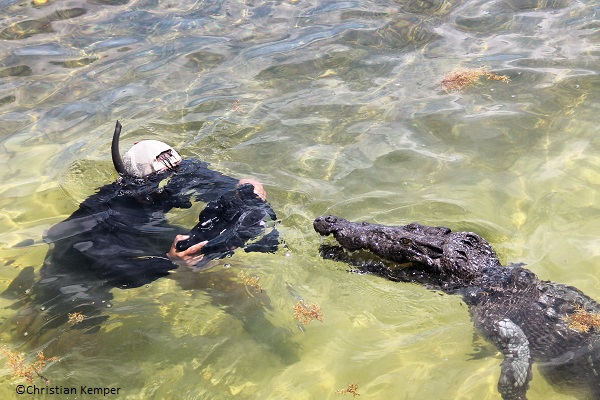
About the crocodiles: In Mexico, or more specifically, in the entire Central American and Caribbean area, live the so-called American crocodiles (Crocodylus acutus) because they are the only species of crocodile in America.
True, there are alligators in the southern states of the U.S. and caimans in South America, but both species are not among the “true crocodiles” (Crocodylidae). There are a total of 27 different species in the world, and all vary in size and behavior. That’s what I try to explain to my friends. Just as there is no such thing as a dog, there is no such thing as a crocodile. A pit bull is something other than a German shepherd or dachshund.
Among the largest, and potentially most dangerous, crocodiles are the Nile crocodile in Africa, the Australian saltwater crocodile or Salty, and the Indian swamp crocodile, also called Mugger. The American crocodile, only at number 4, follows. They are up to 5-meters (16ft) long and have been responsible for 169 attacks on humans in the last ten years (2009-2019), of which 28 were fatal. The last fatal attack was on September 3, 2018, in the Ameca River near Puerto Vallarta in Mexico.
All in all, American crocodiles are not exactly cuddly animals! But compared to the three big species, they are generally less aggressive and somewhat tolerant of humans, if you do not corner them or turn your back on them. But everything is relative.
The brain of a full-grown crocodile is only as big as two fingers of a man. Nevertheless, crocodiles are considered the most advanced reptiles. Crocodilians are among the world’s most popular, as well as the most misunderstood, reptiles. While cultures such as the ancient Egyptians and the Aztecs venerated crocodiles, they have today been reduced to creatures of peril.
Crocodilians in fact, are pivotal to the ecosystems they inhabit, playing the role of super-predators, regulating the populations of terrestrial, aquatic as well as marine prey species, and (as in the case of smaller crocodiles and juveniles) also acting as prey for larger carnivores.
Crocodiles have been around since dinosaurs roamed the earth, and today inhabit every continent except Europe and the poles. They range in size from the massive 6-meter (20ft) Estuarine Crocodile (also the largest living reptile in the world), to the tiny 1-meter (4.9 feet) Dwarf Crocodile. Several species of crocodilians are critically endangered today because of habitat loss and hunting.
Due to the sometimes very remote areas where crocodiles live, comprehensive attack statistics have only been reliable for the past decade, but it is estimated that around 1,000 people are killed by crocodiles each year! By comparison, only 5-10 people worldwide die from shark attacks.
Many people believe that crocodiles live only in swamps and rivers. But the saltwater crocodile in Australia lives, as its name implies, in saltwater. This means it can be found in the ocean or the rivers on the coast, which consist of brackish water. In the sea, on a beautiful coral reef, you might expect a shark attack in the worst case, but never a crocodile attack – which could be a deadly mistake.
Crocodiles also inhabit the adjacent mangrove areas. Do not be fooled; even though crocodiles look lazy on land and are not as elegant in the ocean as dolphins, they are able to swim long distances in the sea. How else could crocodiles have colonized the whole of the Indo-Pacific? How else could they have spread from Honduras to Florida?
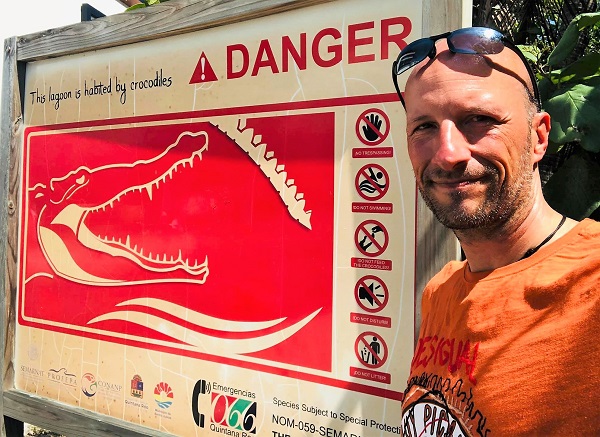
My journey begins in Cancun, Mexico. The city is located on a promontory. On one side is the beautiful Caribbean Sea; on the other side, a lagoon with mangroves. Here, you find signs warning of crocodiles every 100 yards. You’re not supposed to go near the water or go fishing or swimming in the lagoon—if you don’t want to end up in the stomach of a croc!
However, I wonder how serious these signs really are, because in the evening I see dozens of Mexicans standing hip-deep in the water. They fish and enjoy the cool dip in the water, and I discover whole families bathing.
“No hay cocodrilos aqui?” I ask one of the anglers, are there any crocodiles here? “No hay,” not here, he says, and laughs at me, like I’m asking about flying elephants. A bit strange, because he sits directly below a warning sign and his legs dangle in the water.
Rule # 1: Never believe there are no crocodiles in the water just because you do not see any. A five-meter (16 ft) crocodile can stay submerged in knee-deep water for an hour without even a ripple of the water surface!
I have to smile at the sight of the signs, because that’s why I came here—to swim with crocodiles in the water, to look into their eyes without a cage, without protective suit, without weapons.
Continue the story with Rock the Croc! Diving with Crocodiles, Part 2.
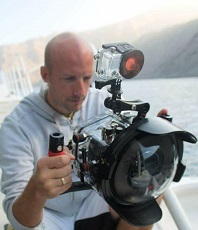
Christian Kemper is a TV journalist from Germany and freelance writer for three of the biggest diving magazines in Germany. He has been diving with and studying sharks for more than 20 years. The author has written two books about shark attacks and is about to publish his first English language book about sharks titled “The Fear Beneath.”
You can find his German Language book “Strange Pool Friends” on Amazon and at tredition.
He has also written several articles about sharks.
